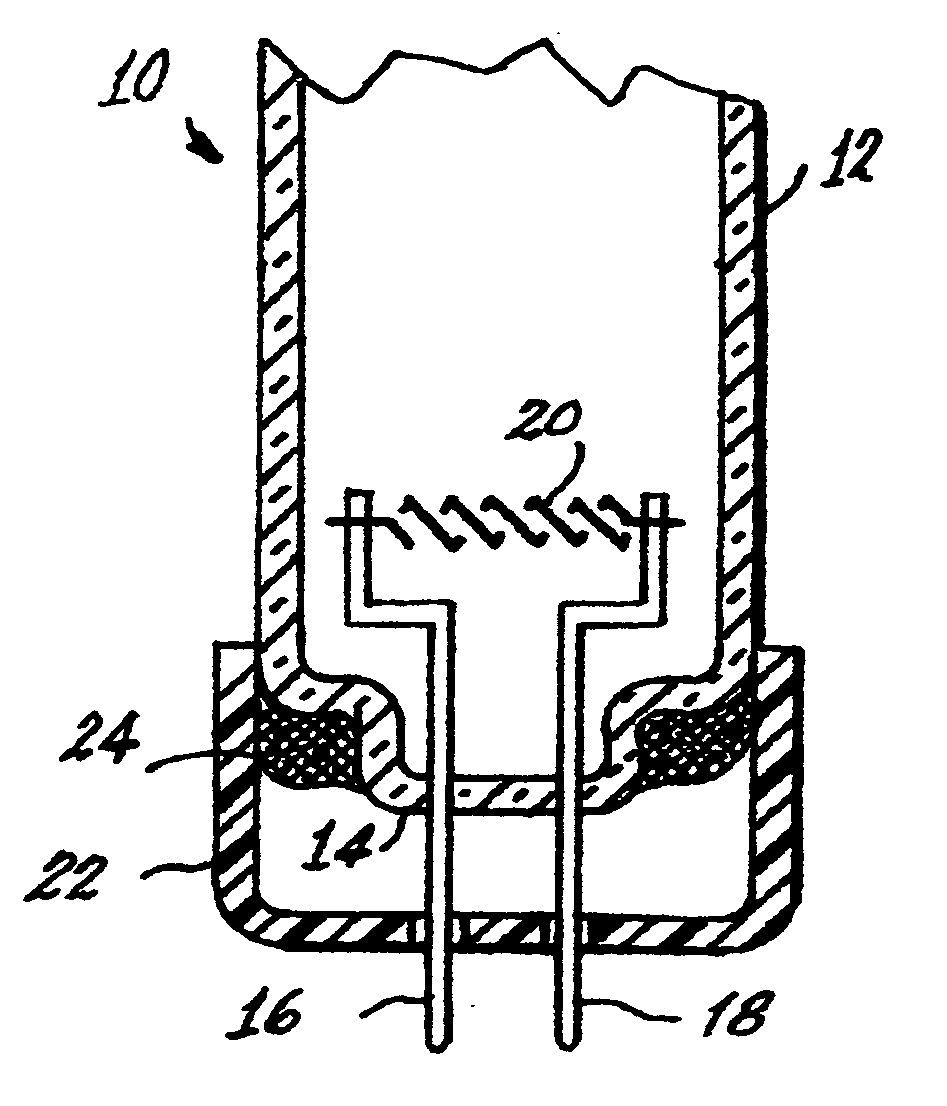Control of mercury leaching
a technology of mercury leaching and mercury vapor, which is applied in the direction of electric discharge lamps, gas-filled discharge tubes, low-pressure discharge lamps, etc., can solve the problems of inconvenient or impossible confinement within a standard lamp envelope, the amount of chemical agents required to chemically combine nearly all of the mercury within a fluorescent lamp may be so large as to be inconvenient or impossible to contain, so as to improve the control of mercury leaching and ensure the effect of removing the mercury
- Summary
- Abstract
- Description
- Claims
- Application Information
AI Technical Summary
Benefits of technology
Problems solved by technology
Method used
Image
Examples
example i
[0027]A series of 12 TCLP tests were carried out with commercial 32WT8 fluorescent lamps manufactured without metallic mercury but with 6 mg of ionic mercury (as HgO, soluble in the TCLP extraction fluid) added at the start of each test. One test was run without the addition of any compound of copper, manganese, or silver. However, each of the other 11 tests included a quantity of silver carbonate (Ag2CO3) and / or manganese carbonate (MnCO3, hereafter referred to as MNC) and / or copper dihydroxy carbonate (Cu2(OH)2CO3, hereafter referred to as CDC). The TCLP test results are listed in Table I, which is organized according to the milli-moles (10−3) of Cu2+ (as CDC), milli-moles of Mn2+ (as MNC), and mg of Ag (as Ag2CO3) that were added at the start of the test.
TABLE ITCLP Results (mg of Extracted Hg per liter of Extraction Fluid) for T8 LampsManufactured without Metallic Hg but with 6 mg Ionic Hg (as HgO) and the IndicatedQuantities of Ag (as Ag2CO3), Cu (as CDC), and Mn (as MNC) Added...
example 2
[0029]Additional TCLP tests were carried out in the same way as those described above. Two tests were run with the addition of 2 mg of silver (as Ag2CO3), with and without the addition of a 1:1 mixture Cu (4×10−4 mole as CDC) and of Mn (4×10−4 mole as MnCO3). Additional tests were run with 0, 1, or 2 mg of Ag (as Ag2CO3) combined with various 1:1 mixtures of Cu (as CDC) and of Mn (as MnCO3). The results of these tests, along with some of those that were described in Example 1, are listed in Table 2 below.
TABLE IITCLP Results (mg of Extracted Hg per liter of Extraction Fluid)for T8 Lamps Manufactured without Metallic Hg but with 6 mgIonic Hg (as HgO) and the Indicated Quantities of Ag (asAg2CO3) and a 1:1 Mixture of Cu (as CDC) and Mn (as MNC)TCLPTCLPTCLPResultsResultsResultswithwithwithTCLP Results2 × 10−44 × 10−46 × 10−4Ag (mg)without Cu ormole Cu andmole Cu andmole Cu andAs Ag2CO3MnMnMnMn00.820.420.210.0810.680.290.080.0220.500.150.050.02
[0030]As shown, the extent of mercury leach...
example 3
[0031]Overall, in the absence of the 1:1 mixture of Cu and Mn, between 5 and 10 times as much silver is required to achieve a particular degree of mercury-leaching control as is needed when the silver is combined with Cu and Mn.
[0032]The tri-partite compound can be introduced into a lamp, for example, a fluorescent lamp 10 shown in FIGS. 1 and 2, by various means. The lamp 10 has an envelope 12 sealed at one end 14. Two electrical lead-ins 16, 18 are sealed into the end 14 and extend into the interior of the envelope and mount a filamentary cathode 20. The lead-ins 16 and 18 project from a base 22 to the exterior of the lamp for connection to a power source. The base 22 is cup-shaped and is sealed to the envelope 12 by a basing cement 24, which can be formulated to include the tri-partite compound.
[0033]Alternatively, the lamp can contain the tripartite compound as a coating 25 applied to the inside surface 26 of the base or be contained within a sealed, rupturable container 28, whi...
PUM
| Property | Measurement | Unit |
|---|---|---|
| particle size | aaaaa | aaaaa |
| surface area | aaaaa | aaaaa |
| concentration | aaaaa | aaaaa |
Abstract
Description
Claims
Application Information
 Login to View More
Login to View More - R&D
- Intellectual Property
- Life Sciences
- Materials
- Tech Scout
- Unparalleled Data Quality
- Higher Quality Content
- 60% Fewer Hallucinations
Browse by: Latest US Patents, China's latest patents, Technical Efficacy Thesaurus, Application Domain, Technology Topic, Popular Technical Reports.
© 2025 PatSnap. All rights reserved.Legal|Privacy policy|Modern Slavery Act Transparency Statement|Sitemap|About US| Contact US: help@patsnap.com


